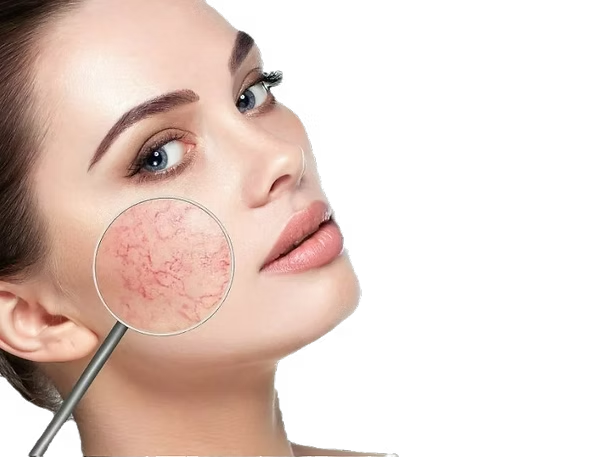Rosacea is considered a vascular disorder that has noticeable characteristics including persistent skin redness, red papular and pustular bumps, dilated blood vessels on the face, and thickened skin texture; all of which can present on a cycle of flare-ups and remissions.
While spider veins can be prevented by managing your lifestyle, the same can’t be said of rosacea. Though lifestyle factors such as stress can act as a risk factor, changing your behavior may have little impact if you have inherited a skin condition.
In rosacea, the blood vessels become engorged, so that the skin often appears reddish. Rosacea symptoms come and go, and appear more as a tinge to the skin, like a sunburn, rather than the more distinct vein shapes of spider veins.
Patients with rosacea often have spider veins as well, which can muddy the waters for the layperson to determine the type of skin condition.
Another level of complication is that rosacea can be divided into four further types, each with its own set of symptoms, and many patients experience symptoms of more than one type of rosacea.
Phymatous rosacea can cause the skin to thicken into scars. This type of rosacea is rare, usually affects the nose, and is more likely to occur in men than women.
If the rosacea symptoms are more persistent than coming and going, this could indicate erythematotelangiectatic rosacea. Prompt treatment is important for this type of rosacea, to make sure the symptoms don’t spread or set in.
Papulopustular rosacea combines the red rash symptoms of rosacea with whiteheads, or blemishes filled with pus. The whiteheads are often misdiagnosed as acne and can occur on the scalp, neck, or chest as well as on the face.
This type of rosacea has symptoms that affect the eyes, making them look watery or bloodshot. Conversely, ocular rosacea can cause the eyes to dry out and become sensitive, so they may feel irritated or have a burning sensation.
Correct Diagnosis Is Critical
Because their root causes – and therefore treatments – are so different, it’s critical to correctly diagnose your symptoms. If you are experiencing what could be spider veins or rosacea, book your visit to the Vein Care clinic in Melbourne, so that you can find out for certain. Our medical professionals will help you to adjust your exposure to risk factors to manage the symptoms, as well as offering state-of-the-art spider vein treatments.


One of the most common symptoms of rosacea is the increased visibility of blood vessels in the skin. Lasers can be used to decrease the redness of the skin while other lasers can be used to decrease the thickening skin that can accompany rosacea. Laser vein removal selectively treats the target of hemoglobin without causing thermal damage to the surrounding tissue.
Broken capillaries and blood vessels (aka spider veins) are commonly found on the face and chest and can be caused by genetics, incorrect product usage, trauma, and internal/external factors.
The laser works by delivering a very fine focused beam of light that is absorbed by haemoglobin in the veins and the heat produced causes photocoagulation. This results in these blood cells becoming hot and creating a clotting effect, which collapses or closes the vein while causing no surrounding tissue damage.
The body will then slowly remove the collapsed veins during the skin’s natural healing response resulting in the reduction of veins and redness
At Lotus, our Clarity II Laser platform, a multi-purpose laser, can be used to treat a very effectively wide variety of defined pigmentation and skin lesion conditions, including Rosacea. Vascular lesions sometimes appear due to sun damage, genetics, and the normal aging process; they can happen naturally or be a result of an environmental source.
Our experienced medical staff will walk you through all the necessary steps for the best results.
Lotus @ Queensway Medical is a full-service cosmetic medicine as well as a family medicine practice located in Etobicoke, ON.